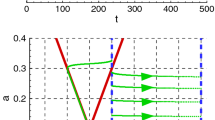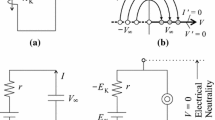Abstract
The conductance-based refractory density (CBRD) approach is an efficient tool for modeling interacting neuronal populations. The model describes the firing activity of a statistical ensemble of uncoupled Hodgkin–Huxley-like neurons, each receiving individual Gaussian noise and a common time-varying deterministic input. However, the approach requires experimental validation and extension to cases of distributed input signals (or input weights) among different neurons of such an ensemble. Here the CBRD model is verified by comparing with experimental data and then generalized for a lognormal (LN) distribution of the input weights. The model with equal weights is shown to reproduce efficiently the post-spike time histograms and the membrane voltage of experimental multiple trial response of single neurons to a step-wise current injection. The responses reveal a more rapid reaction of the firing-rate than voltage. Slow adaptive potassium channels strongly affected the shape of the responses. Next, a computationally efficient CBRD model is derived for a population with the LN input weight distribution and is compared with the original model with equal input weights. The analysis shows that the LN distribution: (1) provides a faster response, (2) eliminates oscillations, (3) leads to higher sensitivity to weak stimuli, and (4) increases the coefficient of variation of interspike intervals. In addition, a simplified firing-rate type model is tested, showing improved precision in the case of a LN distribution of weights. The CBRD approach is recommended for complex, biophysically detailed simulations of interacting neuronal populations, while the modified firing-rate type model is recommended for computationally reduced simulations.






Similar content being viewed by others
References
Borg-Graham L (1999) Interpretations of data and mechanisms for hippocampal pyramidal cell models. Cereb Cortex 13:19–138
Brette R (2015) What is the most realistic single-compartment model of spike initiation? PLoS Comput Biol 11:e1004114
Brunel N, Hakim V (1999) Fast global oscillations in networks of integrate-and-fire neurons with low firing rates. Neural Comput 11:1621–1671
Buchin AJ, Chizhov AV (2010) Modified firing-rate model reproduces synchronization of a neuronal population receiving complex input. Opt Mem Neural Netw 19:166–171
Cain N, Iyer R, Koch C, Mihalas S (2016) The computational properties of a simplified cortical column model. PLoS Comput Biol 12(9):e1005045
Chizhov AV (2014) Conductance-based refractory density model of primary visual cortex. J Comput Neurosci 36(2):297–319
Chizhov AV, Graham LJ (2007) Population model of hippocampal pyramidal neurons, linking a refractory density approach to conductance-based neurons. Phys Rev E 75:011924
Chizhov AV, Graham LJ (2008) Efficient evaluation of neuron populations receiving colored-noise current based on a refractory density method. Phys Rev E 77:011910
Chizhov AV, Rodrigues S, Terry JR (2007) A comparative analysis of a firing-rate model and a conductance-based neural population model. Phys Lett A 369:31–36
Christodoulou C, Bugmann G (2001) Coefficient of variation vs. mean interspike interval curves: what do they tell us about the brain? Neurocomputing 38–40:1141–1149
Eggert J, van Hemmen JL (2001) Modeling neuronal assemblies: theory and implementation. Neural Comput 13:1923–1974
Fourcaud-Trocmé N, van Vreeswijk C, Hansel D, Brunel N (2003) How spike generation mechanisms determine the neuronal response to fluctuating inputs. J Neurosci 23:11628–11640
Gerstner W, Kistler WM (2002) Noise in spiking neuron models. In: Spiking neuron models: single neurons, populations, plasticity. Cambridge University Press, Cambridge, pp 147–200
Gerstner W, Kistler WM, Naud R, Paninski L (2014) Introduction: neurons and mathematics. In: From single neurons to networks and models of cognition. Cambridge University Press (CUP), Cambridge, pp 395–416
Harrison L, David O, Friston K (2007) Neuronal models of ensemble dynamics. In: Statistical parametric mapping. Elsevier BV, Amsterdam
Ilin V, Malyshev A, Wolf F, Volgushev M (2013) Fast computations in cortical ensembles require rapid initiation of action potentials. J Neurosci 33:2281–2292
Iyer R, Menon V, Buice M, Koch C, Mihalas S (2013) The influence of synaptic weight distribution on neuronal population dynamics. PLoS Comput Biol 9:e1003248
Johannesma PIM (1968) Diffusion models for the stochastic activity of neurons. In: Caianiello ER (ed) Neural Networks: Proceedings of the School on Neural Networks Ravello, June 1967. Springer-Verlag, Berlin, Heidelberg, pp 116–144
Knight BW (1972) Dynamics of encoding in a population of neurons. J Gen Physiol 59:734–766
Knight BW, Omurtag A, Sirovich L (2000) The approach of a neuron population firing rate to a new equilibrium: an exact theoretical result. Neural Comput 12:1045–1055
Kopell N, Ermentrout GB, Whittington MA, Traub RD (2000) Gamma rhythms and beta rhythms have different synchronization properties. Neurobiology 97(4):1867–1872
Lansky P, Sanda P, He J (2006) The parameters of the stochastic leaky integrate-and-fire neuronal model. J Comput Neurosci 21:211–223
Naud R, Gerstner W (2012) Coding and decoding with adapting neurons: a population approach to the peri-stimulus time histogram. PLoS Comput Biol 8:e1002711
Nykamp DQ, Tranchina D (2000) A population density approach that facilitates large-scale modeling of neural networks: analysis and an application to orientation tuning. J Comput Neurosci 8(1):19–50
Omurtag A, Knight BW, Sirovich L (2000) Dynamics of neuronal populations: the equilibrium solution. SIAM J Appl Math 60:2009–2028
Payeur A, Maler L, Longtin A (2015) Oscillatory like behavior in feedforward neuronal networks. Phys Rev E 92(1):012703
Shriki O, Hansel D, Sompolinsky H (2003) Rate models for conductance-based cortical neuronal networks. Neural Comput 15:1809–1841
Softky WR, Koch C (1993) The highly irregular firing of cortical cells is inconsistent with temporal integration of random EPSPs. J Neurosci 13:334–350
Song S, Sjostrom PJ, Reigl M, Nelson S, Chklovskii DB (2005) Highly nonrandom features of synaptic connectivity in local cortical circuits. PLoS Biol 3:e68
Tchumatchenko T, Malyshev A, Wolf F, Volgushev M (2011) Ultrafast population encoding by cortical neurons. J Neurosci 31:12171–12179
Teramae JN, Fukai T (2014) Computational implications of lognormally distributed synaptic weights. Proc IEEE 102:500–512
Volgushev M (2015) Cortical specializations underlying fast computations. Neuroscientist 22:145–164
Acknowledgements
This work was supported by the Russian Science Foundation (Project 16-15-10201).
Author information
Authors and Affiliations
Corresponding author
Rights and permissions
About this article
Cite this article
Chizhov, A.V. Conductance-based refractory density approach: comparison with experimental data and generalization to lognormal distribution of input current. Biol Cybern 111, 353–364 (2017). https://doi.org/10.1007/s00422-017-0727-9
Received:
Accepted:
Published:
Issue Date:
DOI: https://doi.org/10.1007/s00422-017-0727-9




